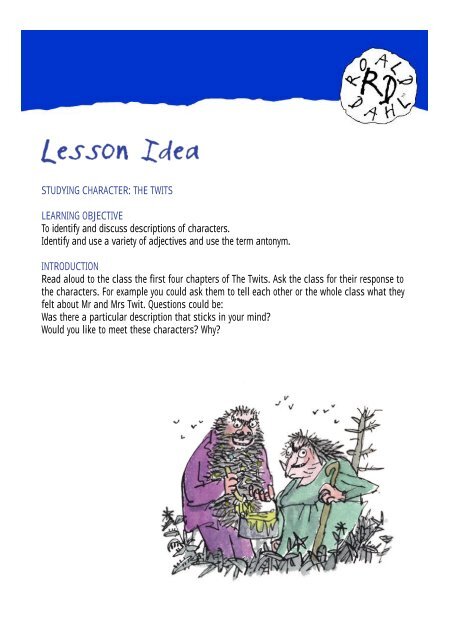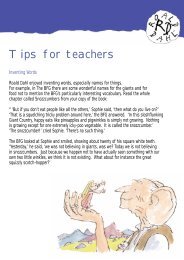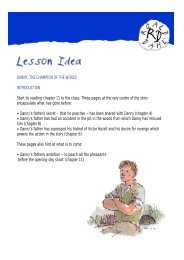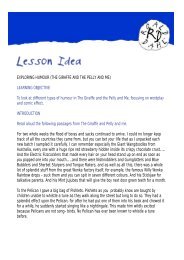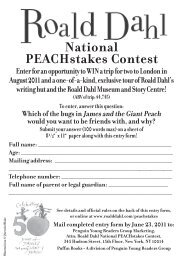STUDYING CHARACTER: THE TWITS LEARNING ... - Roald Dahl
STUDYING CHARACTER: THE TWITS LEARNING ... - Roald Dahl
STUDYING CHARACTER: THE TWITS LEARNING ... - Roald Dahl
Create successful ePaper yourself
Turn your PDF publications into a flip-book with our unique Google optimized e-Paper software.
<strong>STUDYING</strong> <strong>CHARACTER</strong>: <strong>THE</strong> <strong>TWITS</strong><br />
<strong>LEARNING</strong> OBJECTIVE<br />
To identify and discuss descriptions of characters.<br />
Identify and use a variety of adjectives and use the term antonym.<br />
INTRODUCTION<br />
Read aloud to the class the first four chapters of The Twits. Ask the class for their response to<br />
the characters. For example you could ask them to tell each other or the whole class what they<br />
felt about Mr and Mrs Twit. Questions could be:<br />
Was there a particular description that sticks in your mind?<br />
Would you like to meet these characters? Why?
FOCUS<br />
All read about Mr Twit (Chapter Two entitled Mr Tw i t ) :<br />
"Mr Twit was one of these very hairy-faced men. The whole of his face except for his<br />
f o rehead, his eyes and his nose, was covered with thick hair. The stuff even sprouted<br />
in revolting tufts out of his nostrils and ear- h o l e s .<br />
Mr Twit felt that his hairiness made him look terrifically wise and grand. But in truth<br />
he was neither of these things. Mr Twit was a twit. He was born a twit. And now at<br />
the age of sixty, he was a bigger twit than ever.<br />
The hair on Mr Tw i t ’s face didn’t grow smooth and matted as it does on most hairy - f a c e d<br />
men. It grew in spikes that stuck out straight like the bristles of a nailbrush.<br />
And how often did Mr Twit wash this bristly nailbrushy face of his?<br />
The answer is NEVER, not even on Sundays.<br />
He hadn’t washed it for years."
Get the children to work in pairs to underline the words and phrases that tell us about what Mr<br />
Twit looks like. Discuss the childre n ’s choices of words, particularly identifying and listing the<br />
adjectives.<br />
Now read about Mrs Twit (Chapter Four entitled Mrs Twit) and do the same activity. This will<br />
e n s u re that all children are familiar with the extracts before starting their own tasks, which can<br />
be done in pairs or gro u p s .<br />
"Mrs Twit was no better than her husband.<br />
She did not, of course, have a hairy face. It was a pity she didn’t because that at any<br />
rate would have hidden some of her fearful ugliness.<br />
Take a look at her.<br />
Have you ever seen a woman with an uglier face than that? I doubt it.<br />
But the funny thing is that Mrs Twit wasn’t born ugly. She’d had quite a nice face when<br />
she was young. The ugliness had grown upon her year by year as she got older.
Why would that happen? I’ll tell you why.<br />
If a person has ugly thoughts, it begins to show on the face. And when that person<br />
has ugly thoughts every day, every week, every year, the face gets uglier and uglier<br />
until it gets so ugly you can hardly bear to look at it.<br />
A person who has good thoughts cannot ever be ugly. You can have a wonky nose and<br />
a crooked mouth and a double-chin and stick-out teeth, but if you have good thoughts<br />
they will shine out of your face like sunbeams and you will always look lovely."
1.Find words in the passage about Mr Twit to write in the labels. Can you find something to<br />
copy about his ‘nostrils and ear-holes’, his hair and his beard?
2. Words with opposite meanings are called antonyms. Look at this list of antonyms.<br />
nasty/nice<br />
friendly/unfriendly<br />
kind/unkind<br />
mean/generous<br />
ugly/beautiful<br />
clean/messy<br />
Chose one antonym from each pair to complete six sentences:<br />
The Twits are people.<br />
The Twits are people.<br />
The Twits are people.<br />
The Twits are people.<br />
The Twits are people.<br />
The Twits are people.
3. In The Twits <strong>Roald</strong> <strong>Dahl</strong> tells us that a person who has good thoughts can never be ugly.<br />
Choose the words to fill in the spaces:<br />
good ugly double stick-out<br />
mouth sunbeams lovely wonky<br />
A person who has goods thoughts can never be . You can have a<br />
nose and a crooked and a chin<br />
and teeth, but if you have ____ thoughts they will shine out of<br />
your face like and you will always look .<br />
5. Imagine that Mr and Mrs Twit have a dog that is as horrible as they are.<br />
What would it look like? Look back to the descriptions of Mr and Mrs Twit to help with ideas.<br />
Write a short description of the dog.
Ask children to feed back on their tasks. Ask appropriate children to point out any words that<br />
are adjectives. Enjoy the full unpleasantness of the shared pages by reading them aloud,<br />
again inviting all the children to join in with exaggerated expression.


